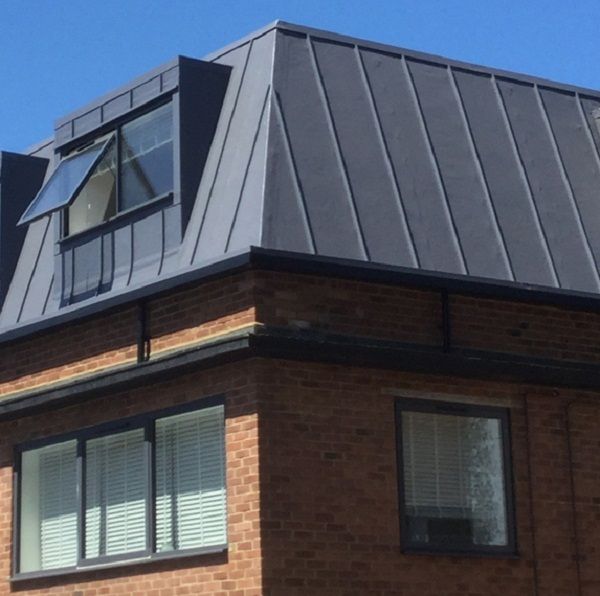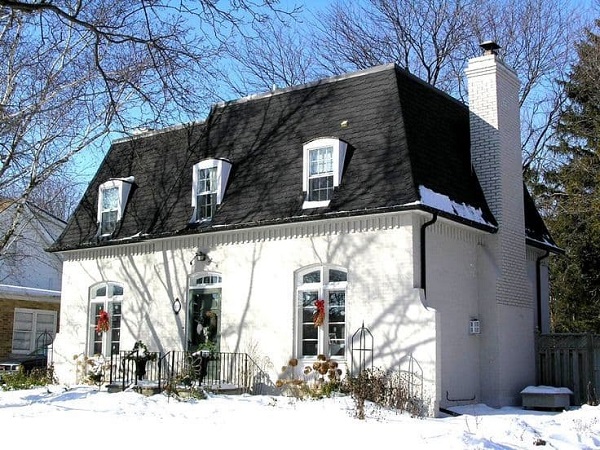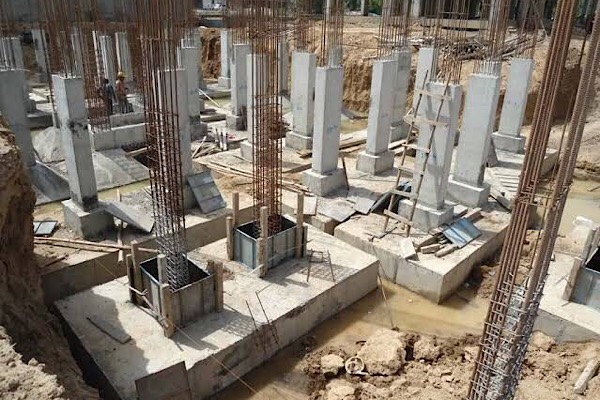A mansard or mansard roof is a four-sided gambrel-style hip roof characterised by two slopes on each of its sides with the lower slope, punctured by dormer windows, at a steeper angle than the upper.
The word ‘Mansard’ means the actual loft inside the roof, not just the shape of the roof. or French roofs are very similar to the design of a gambrel roof in that they also consist of four sides.
This curb-style roof has two separate slopes with a steeper angle to one side for better drainage. The dormer window offers a larger floor area, the so-called garret. Since the upper slope of the mansard roof is flatter, it is rarely visible from the ground.
The flat roof then provides maximum space under the roof. Most mansard roofs have multiple skylights for maximum light and ventilation. While mansard roofs are not commonly found in modern houses, they are often incorporated into French-style buildings, such as Second-Empire-style houses.
The mansard roof is, in fact, a defining feature of this style of the house, which offers an entire living floor on top of a horizontal decorative design without adding to the number of storeys in the building.
Did You Know?
One of the most famous buildings with a beautiful mansard roof is the Germania Life Insurance building in New York. This unique four-storey building was built in 1911 and is one of the best examples of a modern mansard roof conversion.
Types Of Mansard Roofs
A mansard roof is generally divided into two types;
1. Sloping or Steep sides of a Mansard Roof – Sloping or steep sides of mansard roofs form a sharp point on the roof and provide drainage on all sides of the roof.
2. Double Pitch Mansard Roof- The Double Pitch Mansard covers the lower roof and provides sufficient drainage.
Materials Used In Mansard Roof
1. Asphalt
Asphalt is a widely used material for mansard roof construction. In today’s market, the price of asphalt ranges between $ 50 and $ 150 per square foot, and the average service span is between 20 and 30 years.
Asphalt is ideal for building mansard roofs in areas with high snow cover, rain, high temperatures, and especially sunshine areas.
2. Ceramic and Cement tiles
Clay or ceramic tiles are mostly used when exposed to extensive sun exposure in hot climates. On the other hand, cement and ceramic have been added to the mansard roof structure. During the hot summer, they keep the building colorful because it is a natural product, reflecting sunlight.
Both tiles have so many problems that they sometimes do not resist and crack or break in severe frost, but both have good fire resistance. This type of tile has a lifespan of up to 50 years and has very low maintenance costs like natural wood.
3. Synthetic and Wooden Shingles
In this roofing system, synthetic roofing materials are the easiest to maintain. This material is made from recycled materials, such as recycled wood, a mixture of plastics, rubber, making it more eco-friendly and more sustainable.
This material easily withstands all-natural extreme conditions such as snow, rain, wind, and extreme temperatures without cracking or damage.
Among the materials, the price of this material is moderate, and if you take good care of it, it will take up to 30 to 50 years. On the other hand, natural wood shingles require high maintenance and are expensive.
Advantages
1. More Usable Space
Thanks to its almost vertical inclinations, it offers a convenient way to maximize the construction space of the building. The extra space that this roof provides is even greater than other popular roof styles, such as a hip roof or a gable roof. The additional space provided by this roof is large enough to accommodate the master bedroom.
2. Preferred For Both Rural and Urban Areas
It is suitable for roofing structures in rural and urban areas, as it is suitable for any property that creates usable space. It is most often used in the city because it offers more usable space and offers the possibility of expanding to the top.
3. Better Ventilation
One of the main advantages of mansard roof is that it provides better light and heat distribution in the building structure. The construction of the roof chapels allows more light to enter the building and also speeds up the circulation of natural air inside the building.
Additional space such as the attic formed by the mansard roof supports efficient and excellent heat distribution, making the building more comfortable.
4. Flexible With Modern Design Elements
It is also flexible for adding new modern design elements. The combination of modern design elements in a conventional mansard roof contributes to the aesthetic appearance of the building.
5. Low Cost
This is a great cost-saving roofing option for users. This roof offers cost savings and accelerates the reduction of heating costs because when properly shaped and sealed, it offers better heat distribution in the building.
Incorporating modern design elements into the mansard roof also significantly reduces the overall cost of maintaining the building structure.
Disadvantages
1. Local Laws Restriction
It can be very difficult to obtain permission from local authorities. Depending on the area, there may be different requirements to obtain permission to use a mansard-style roof.
In some areas, local building regulations were found to prohibit the length of a mansard-roofed building from protecting the structure from structural failure and collapse. Therefore, local laws and regulations must be fully understood before building a mansard roof.
2. High Installation Costs
The mansard roof installation process is also quite complicated and requires the long involvement of experienced professionals. For all these reasons, the initial cost of installing and assembling a mansard roof is high, and therefore, the attic may not be suitable for homeowners with a small construction budget.
3. Low Resistance to Weathering
It is not suitable in areas exposed to adverse weather conditions, such as areas with heavy rain or snow.
4. High Maintenance and Repair Costs
Because they offer low resistance to adverse weather conditions, this type of roof structure requires constant maintenance and repairs to prevent further damage and structural failure. Therefore, the maintenance and repairing costs of the mansard roof are also higher.
In areas that are prone to storms, dirt can accumulate on the surface, which, if not quickly cleaned, can cause severe damage to the entire structure.
5. Require More Time
Compared to other roof styles, the time required to install this roof is much longer, and the required building materials and human resources are somewhat higher.
Source: dailycivil











